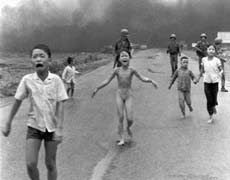|  |
|  |
In The March of Folly the late Barbara Tuchman (one of America's foremost historians) examines an interesting facet of history, namely the tendency of governments to act stubbornly and perversely against their own best interests (this tendency is the "folly" referred to by the title). For Tuchman, a particular course of action must meet three criteria to be considered folly; first, it must have been seen as such by contemporaries, secondly, another, better, course of action must have been available, and lastly, the course of action must have been pursued by a group rather than an individual over the course of more than one political generation (pp. 5 f.) These criteria serve to separate true folly from the incompetence and/or insanity of an individual ruler. To illustrate folly in human history, Tuchman has chosen four "case studies": 1)The decision of the Trojans to bring the Trojan horse into their city, 2)The provocation of the Protestant uprising by the Renaissance Popes, 3)The loss of the American colonies by the British, and 4)The failures of U.S. policy in Vietnam.
The decision of the Trojans, upon being presented with the wooden horse, to bring that fateful object into the city is presented by Tuchman as a sort of archetype for all the folly that has been perpetrated by governments since. The decision does meet two of the criteria presented above; Laocoon's warnings that the Greeks are not to be trusted, and the obvious option of investigating the horse (and its contents) more thoroughly before bringing it into Troy. And, although the fatal decision was "spur-of-the-moment" (thus not meeting the "more than one generation" criterion), it was a group effort. The Trojan horse incident and the less-known (but probably more pertinent) biblical story of Rehoboam serve as excellent early examples of Tuchman's concept of "folly."
After discussing the Trojan horse and other ancient instances of folly, Tuchman turns to more recent history for her next example: the Renaissance Popes from Sixtus IV to Clement VII. Their folly was the continuous use of the Papacy as though it were merely another secular throne, and their refusal to acknowledge and treat with the rising tide of discontent that this abuse created. The discontent, of course, culminated in the Protestant secession. The Popes, meanwhile, lived lives of amazing luxury, appointing friends and relatives to various important positions (including, on a number of occasions, children to bishoprics), maintaining mistresses, and engaging in politics and warfare much as the other European rulers of the time. Worse, they reacted violently to any suggestions of reform (particularly terrifying to the Popes of this period was the possibility that a Council might be convened), seeing therein only a lessening of their own personal, secular, powers. And, as the culmination of their folly, half of Christendom slipped away from the Holy See. There is, of course, a great irony in the fact that these Popes, in the midst of the incredible corruption and decadence of their reigns, left behind one of the greatest artistic legacies of all time.
Moving along the historical time line, Tuchman next discusses the amazing series of events that led to American independence from Britain. The folly here, of course, if that of the British government, which, in the sentiments of many at that time, created a rebellion where no rebellious feeling had been present. This it did by, in the words of a contemporary figure, "asserting a right you know you cannot exert." That right, of course, was the right to tax the colonies without representation. What is amazing about the entire situation is that the British parliament had many opportunities to defuse the situation before independence became a rallying cry of the Americans. Out of ignorance and arrogance, and despite the warnings and advice of any number of competent men on both sides of the Atlantic, it refused to do so, and thus the colonies were lost.
The last of Tuchman's studies concerns The United States' involvement in Vietnam. This is, in some ways, the weakest section in The March of Folly, for Tuchman's own biases, for instance in her brusque dismissal of the popular anti-war movement (see p. 366 et al.), do colour it to a certain extent. The author is, however, entirely scathing in her portrayal of high-level American policy-making at that time. There are eerie parallels here with the British actions prior to and during the American War of Independence, for the Americans faced the Viet Cong, once again, through a fog of arrogance and ignorance, refusing to learn the lessons of Dien Bien Phu and grossly understimating the VCs' willingness to fight (There are also, by the way, some similarities between Vietnam and the recent situation in the Persian Gulf, except that whereas Clinton has accepted a U.N.-brokered peace agreement, Johnson refused to go along with the one put together by U Thant in 1964). And, as in the case of the American Revolution, capable military and political men warned those in power about the certain and dreadful consequences of their policies, and yet those policies were still pursued.
The March of Folly looks at history from an interesting and original angle. It is not a particularly uplifting view of events, for, as Tuchman amply demonstrates, folly has infested the human race since the dawn of recorded history. However, the book does not take an overly pessimistic tone, despite the unpleasantness of the subject. Tuchman's style is eminently readable, making The March of Folly accessable to the average reader, without leaving out details that will be of interest to academics. On the whole, I would say that The March of Folly makes very worthwhile reading.
Reviewed by Patrick Conway on March 20, 1998. Photograph from "Vietnam's Most Harrowing Photo: From Guilt to Grace."